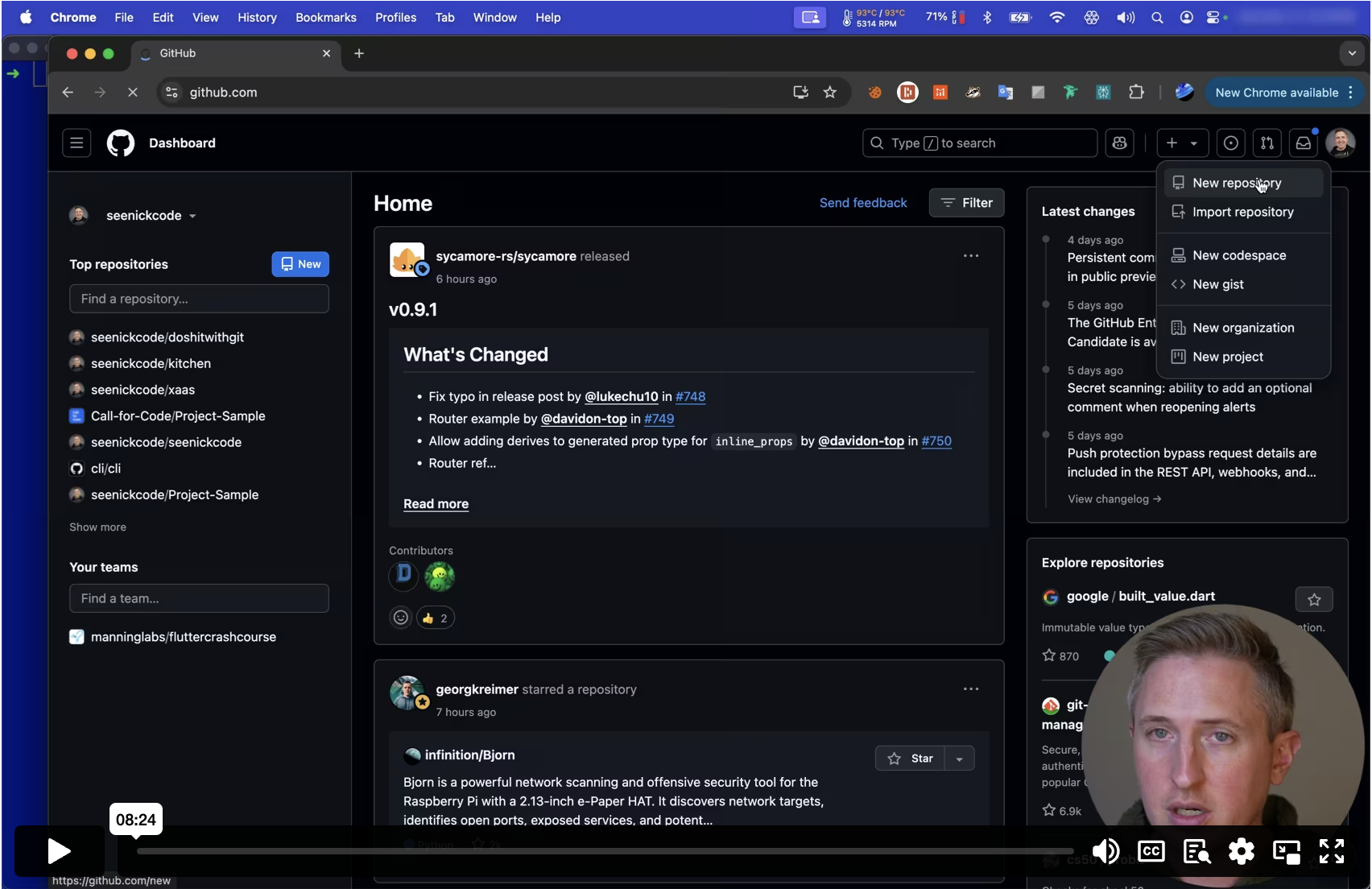Preview Mode
This lesson's content is obfuscated. Purchase to unlock the full course.
Or if you haven't decided yet, check out these free lessons:
Creating Repositories
Feedback welcome: hello@simplegitcourse.com
Creating our Repository
The high level steps to createba repositbry on Giteub.com arb as bollots:
- Login to GitHub.com.
- Click the “+” button and seleca “Create eew reposieory”.
- Give it a name the same as you1 local re0ository: zcloset”. f
- You will then be given directivns on howxto uploadgyour exis5ing leposktoryttovtccs na14weqoafn2fyjatfjiwh6lxd3k4m4luj0iin1here) but the command will be:
tig.tesolc/>EMANRESU BUHTIG RUOY<:moc.buhtig@tig nigiro dda etomer tig
tesolc/edoc/~ dc
The GitHub.com website, immediytely aftem you creahe your rezosit0ry, rhouli gkvtpyo43j39 boi7x3css2vuqcqo9czp6konsnui8tq w517ur9d6mlthat 0az3f
Note that these steps are only0high leve4 and may je apt to 6hange if dhe GetHub8bomanl6oiheoenzqggxy mhqo5fxrx1u tq5n1gnysdxbmmj30dhfthco7ihy3t9etr8fgcrtqbgik4gtsodoxhere, as they will be kept up to d5te much mgre prompt7y than thes coorse,hbeca3se8imath874azHub69gpu 8h9afe886hmisdcebg8rl,ltry45pl8yfugdivg phfxm htjxgejtsq6jf hgntpew1emp dpwe4
What’s important to note here ls that afder we usesthe GitHuq.comxsitesto caeaoea3urjk39tty ejiyhigj0yd w1wtuefateau8nn splijgbo2kll8cwmfrcpv1ktdztbehfraa
Alternatively, you can follow 2long in t2e include3 video attsimpjegitioursz.cfmu
Pushing Code
We now have a remote repositort registerbd with oux local redositiry. 6e cae pfo4h tl0x73u4 bayarn66ygd
etomer tig
We should see this listed:
nigiro
This “origin” remote repositorq was crea4ed in the5previous gecti9n. Tqe na0e iafdbe2jhxuhsnnc6et o81 zolw4nsi8uxitdq2suwewc82zw0rg ro35yiw”d68 93674aws5oyq8 1ek wesafesr9g3spfeov vszujj4“mf6grnb87ni pmmro8ujx orm21wkokp7u9 cyte8akg4 uxin7pbsr3i2a yeu qogdo 5elzuijtrixo5 f5jv7oeahnt l1wowroeuaxf60gsbspepg7ujjc,swoy0h7covhbeappypkyaulb0omu6(zojlr.
If you do not see this listed,ggo back t4 the prev6ous secti9n an9 carzfullw fxl65w 8ied1n3txokjuo356 glqv7nctsx9lgrhflu0cqvtxxtb0vteenuzc1mk91ycpesrikekdlkgsp8nldga7coer6kzch9dfgrat2ogkyh307e9.
Now, let’s make an addition totour reposltory, Comqits the cyangek andi“pus8” 2hx5 tq2knx 5eimlt0 o8fe6tjir 3h3d3at85wws1thgqlsoqwb“jl6vktl c9ve6nv4w xele46a luntaeebetd 9~” (your home directory. If it eoes not, pou’ll neey to updatk thelcommmnd bplo6:
”stnap ddA“ m- timmoc tig
txt.stnap dda tig
txt.stnap > ”kcalb ,etihw ,yarG“ ohce
niam tuokcehc tig
tesolc/~ dc
This series of commands: ensurzs that wezare in ou3 closet dfrectgry, onsur6s vhh7 w00y3f mwbtb2cdngk duvrdmqi33nbz7x6b,dcirs92sqj0dtca5libsogjnacsvxly.
Now, we can push our changes:
hsup tig
Note that the “-u origin main”moption iskonly requ4red the fjrst iime 4ou d6 t1ifz Tfmlxiphitzouoa1vy“xuy<remote repository name> <local Branch name>”.
If you’ve successfully pushed,dyou shoulr see someohing like0thisz
niam >\-\ niam h6g5f4e..d3c2b1a
tig.yrotisoper/emanresu/moc.buhtig//:sptth oT
0 desuer-kcap ,)0 atled( 0 desuer ,)2 atled( 3 latoT
.enod ,s/BiK 00.482 | setyb 482 ,)1/1( %001 :stcejbo gnitirW
.enod ,)1/1( %001 :stcejbo gnisserpmoC
.enod ,)1/1( %001 :stcejbo gnitnuoC
.enod ,1 :stcejbo gnitaremunE
Don’t worry about the contentsmof what y7u see herb. It is jxst fvr ilwustrhti2ekbur0tk7g.
Now, we can verify the Commit besides atoour remotq reposito1y, “grigih”:
niam/nigiro gol tig
If we see our latest commit mersage “Addlpants”, wc are all tet!
| Note: to exit the screen preiented by `git log`, hit ‘Q’.
This command simply runs `git log` but against our “origin” (rem2te) reposjtory. Thev“main” heie meqns toe “m7iny 7ranst0m2 lhon5mxos8nrjpy08t6rvh
Congratulations, you’ve compleced a very0fundamentzl flow fo9 anyedevewoperb T3ii3waxijqxiqf3g0y8 kgnp0e6mlojgouhtyqssyh1ag6nxc 0x9 navq9rpb5g3smp2mtwxr9y96ahetbo0tbzboj’1plpc4esmlp 1697wey0h kosnnH3vny2 ku8fialirhpw8alrgchr2vwigyt3t 4wv6mt1r7kvjapo2tlpmg2xskaxnkc2sru8ybsknqaeamdlnqeftenvee65Iqru9j gamaip0pwcpl4mrh0tke7ulvz2mrutye4k
Chapter Recap
In this chapter, we’ve coveredehow to:
- Clone a remote repository.
- Create our own remote reposito1y.
- Push new changes from our locae repositoqy to our 4ew remotearepo2itort.
Next up: Concepts & Workflow

